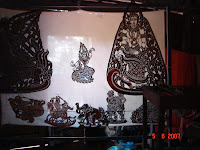As usual I was very excited, looking forward to experience another kind of Asian Performing Art, in a region where “another revolution” (like in China) had destroyed or almost erased any form of culture. It is true that many efforts are being made in the Capital, Phnom Penn, but as it was impossible for me to visit I thought some group in this province would be, if not fantastic, at least interesting to see how they tried to keep the traditional way to perform. And it was interesting, there is a group trying to keep the art, but they are now at a very beginning level, they are only children.
A French organization has taken care of many Cambodian children, and one way to help them is teaching them some of the Cambodian traditional arts. They are doing well, working hard and performing at least once per week, but it their skills are still immature, I think.
 Despite those special conditions, the experience was really interesting: the musicians who play in the show are very good and make the evening more enjoyable, and some traditional chants are very nice too.
Despite those special conditions, the experience was really interesting: the musicians who play in the show are very good and make the evening more enjoyable, and some traditional chants are very nice too.Three plays where performed that night: “Two monkeys fighting”, “Buffalo fighting”, and “The kidnapping of Sita”. I took a video of every one (around 10 minutes long each) and I transcribed the anecdote the restaurant provided.
Two Monkeys Fighting (video)
“This is the story of a black and white monkey. The story takes place in a small village where a black monkey is known to steal and eat all of the harvest that the villagers spend so much time cultivating. The white monkey starts to feel annoyed by the attitude and behavior of the black monkey and decides to talk with him, explaining to him the reasons why he should not to do this. The black monkey doesn’t care and doesn’t want to listen. From thus day forth, the two monkeys start to fight. One day, an old women passes by the two monkeys and sees them fighting. She decides to bring them to the monks who are the only ones who can speak the secret monkey language. After a long and wise discussion, the black monkey agrees to behave and apologizes to the white monkey. They return to the village and the black monkey never steals again and even helps the villagers with their daily duties.”
Buffalo Fighting and The Forbidden Bets (video)
“A man –depicted in this story by a long-beaked bird- comes back from a hard day of work in the fields with his buffalo and meets a young woman who also has a buffalo, traveling in the opposite direction. Upon seeing the man’s buffalo, the young woman suggests they bet for a buffalo fight: the loser must give money to the winner. While fighting, one of the buffalo dies and the other one escapes. The man is very unhappy that his buffalo died and asks the woman to give him another one. The woman refuses as she has also lost her buffalo. At this point, the young lady and the man start to argue and to fight. A policeman arrives and asks them what has happened. They start to explain but, as bets are illegal in Cambodia, the policeman decides to arrest them both. It looks like they both lost!”
The Kidnapping of Sita (extract from the Ramayana) (video)
“King Rama is walking in the forest with his wife Sita and his brother. They decide to stop and take a rest. They soon fall asleep after their long journey. Ravana, King of the giants, is very much in love with Sita and would do anything to kidnap her. Cleverly disguised as a deer, then as an old man, he ends up successfully kidnapping his love, Sita.”
(1) La Noria restaurant, Siem Reap, Cambodia. June 6th, 2007. 19:30 p.m.





